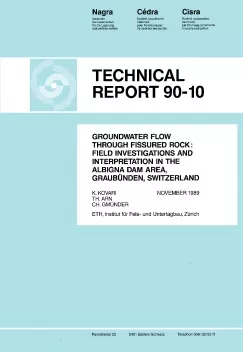
Technical Report NTB 90-10
Groundwater Flow Through Fissured Rock: Field Investigatons and Interpretation in the Albigna Dam Area, Graubonden, Switzerland
The knowledge of hydraulic conductivity of rock plays a central role in the planning of underground repositories for disposal of radioactive and other industrial wastes. Estimates of the amount of dissolved substances that could reach the biosphere through groundwater flow in the course of time are based on rock-hydraulic considerations and model calculations. The aim of this research project was to help clarify the characteristics of flow in fissured rock. Activities centered mainly on field measurements and on an interpretation of the measured data using numerical calculations.
The rock foundation of a dam was chosen as the site for repeated observations of flow patterns in a fissured rock. The advantage of this type of location is that the rock is exposed to pressure gradients subject to considerable seasonal fluctuations. As a rule, good accessibility is also assured, enabling a large expanse of rock to be explored by means of boreholes fitted with instruments.
Our project was carried out at the Albigna Dam in the Canton of Graubünden, Switzerland, where the greatest fluctuation in the level of the lake was approximately 100 m. In the area of the dam the rock consists of a fresh, solid granite, whose fissure systems were well known as regards position and distribution. The measurement program for assessing the flow conditions consisted of two elements: piezometrie pressure measurements in boreholes and strain measurements in boreholes. Pressure measurements were accomplished to define the potential field. Strain measurements were accomplished to detect fracture opening and closing as a function of the fluctuations in the lake level. From a combination of the two sets of observations it was hoped to be able to determine the interaction between hydraulics and mechanics, i.e. the coupling of two key processes with a possible influence on a changing permeability of the rock. The instrumentation was positioned in a plane perpendicular to the dam wall in the central area of the dam. Five boreholes between 50 and 60 m long which included approximately 40 measurement points were used for the piezometer measurements. Two additional boreholes positioned laterally to the measuring plane were used for control purposes. Using the "sliding micrometer", the continuous strain distribution was determined along two boreholes in the measuring plane. Pressures were measured using the "Piezodex" system. These two high-precision instruments are portable probes whose proper working and accuracy can be checked at any time.
The results of the piezometer measurements are presented first in tabular form and then in graphic form. The key factors for piezometrie pressure are the position of the given measuring point and the height of water in the lake at the time of taking the reading. The most significant factor influencing the strains is the presence of certain mechanically active large fissures. Comparing the piezodex measurements with the sliding micrometer measurements produces a correlation between the rock deformations and the hydraulic potential. It was discovered that the opening and closing of two large fissures at the foot of the dam on the lake side had a crucial bearing on the distribution of potential. The potential field was constructed by linear interpolation of the values on a network of triangles in the area characterised by a large number of measuring points.
The mathematical investigations were conducted with the AQUA-ROCK finite element program on a 2D-model. Three main conceptually different models were investigated in particular. In the first main model the rock foundation was assumed to be a homogeneous and isotropic continuum. In the second main model the main fissures were idealized as a uniformly distributed and infinitely extending fissure system in accordance with SNOW (1965). In the third main model the foundation was assumed to be a homogeneous isotropic medium penetrated by two large fissures and the drainage boreholes.
From just a visual comparison of the measured and calculated values it is clear that a different model achieves the best correlation depending on the level of the lake. For the maximum lake level, however, it is essential to take account of the action of the fissures either by way of the idealization according to Snow (main model 2) or by considering the individual fissures (main model 3).
